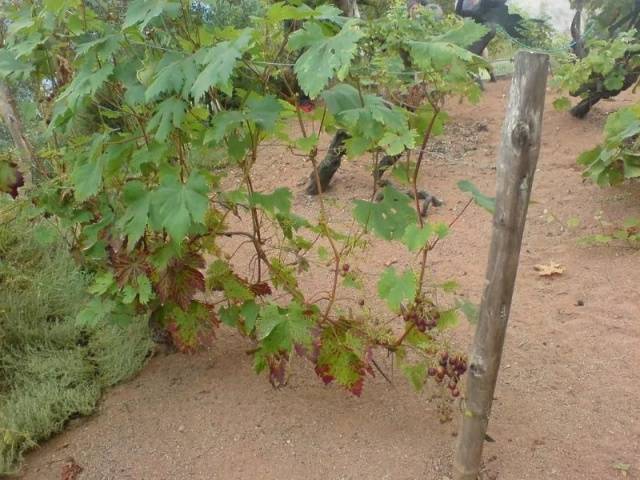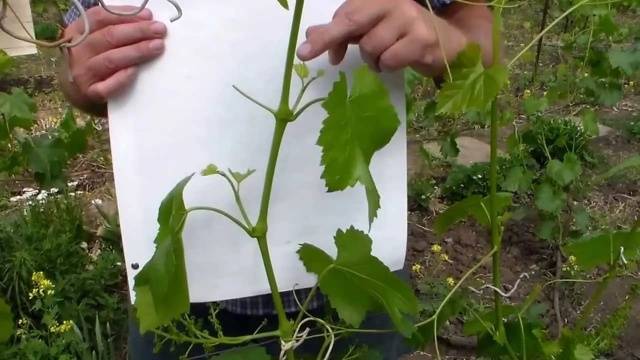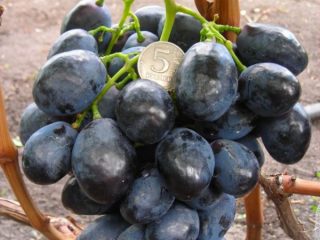Content
Seedless grapes have always been popular with consumers. Breeders do not stop working and obtain new varieties and hybrids that quickly ripen and at the same time have an attractive presentation. In 2009, a new grape variety Veles appeared, thanks to the efforts of winegrower V.V. Zagorulko. The variety was bred on the basis of Rusbol grapes and Sofia, has large, early-ripening clusters. The variety is named after the Slavic god of fertility Veles.
Description of Veles grapes
Veles grapes are an early ripening hybrid variety. About 100 days pass from the appearance of the first leaves to the ripening of the fruits. The Veles grapevine grows and ripens quickly. One fruiting shoot forms 2-4 flower clusters. Flowers are bisexual. The plant does not need additional pollination, however, if you want to increase the yield, you can resort to artificial pollination.
As the crop ripens, stepsons form on the vine, which can produce an additional harvest by mid-September.
In the description of the Veles grape variety, the weight of a bunch of grapes is indicated from 600 g to 2 kg; according to reviews and photos of winegrowers, a bunch can ripen up to 3 kg. The shape of the Veles grape bunch is cone-shaped, very voluminous, not very dense or loose.
The berries are oval in shape, weighing up to 5 g, the skin is thin, but quite dense, does not allow the berries to crack, the color of the berries when the fruit is technically ripe is pink, only rudiments of the seeds remain - the rudiments of seeds, which are not felt when eaten.
Thanks to the thin skin of the Veles variety, the berries are visible in the sun, which makes them aesthetically attractive to the buyer. The pulp of the berries is dense, jelly-like, pleasant taste with a nutmeg tint.
Kishmish Veles grapes are a frost-resistant variety that can withstand temperatures down to -23°C. Suitable for central Russia if the plant is covered for the winter. In the southern regions it is possible to obtain 2 harvests.
Watch a video about Veles grapes:
Features of growing grapes
The Veles variety is planted using either cuttings harvested in the fall or ready-made seedlings. Young plants take root well in any case and can bear the first signal fruits already in the second year. It is recommended to remove the inflorescences that appear, so as not to delay the seedling’s energy for the development and ripening of fruits, but to direct them to the ripening of shoots.
Veles grapes do not place high demands on soil quality. Can grow on sandstones, loams or clay soils. Regardless of the soil, humus, peat or compost is placed in the planting hole and mixed with the soil. Broken brick and expanded clay are placed at the bottom of the hole for drainage if the soil is dense clay. Despite the fact that the seedling is still small, the dimensions of the planting hole should be at least 0.8 x 0.8 m.
When planting the Veles variety, take into account the direction of the rows from north to south and the distance between seedlings of at least 1.5 m. The planting pit should be as well filled with organic matter as possible, since this is food for the grapes in the next 3-4 years.You can add superphosphate (300 g), ash (500 g), potassium salt (100 g).
While the plant is young, it will require more careful care. Loosen and regularly water, remove weeds. If you cover the top layer of soil under the grapes with mulch, maintenance can be reduced, since mulch prevents the growth of weeds and reduces moisture evaporation. Peat can be used as mulch.
An adult plant of the Veles variety does not require frequent watering, especially when the fruits ripen, excess moisture can cause the Veles grapes to crack and rot. Watering is carried out no more than 4 times per season, at the most critical moments of plant development.
When planting, be sure to provide support. This can be a simple trellis made of a dug base - pillars and several rows of wire stretched between them. The wire must be strong enough and tightly stretched, since it will have to withstand the considerable weight of the grapes and their ripening fruits.
A sufficient amount of space is left between the trellises, convenient for care, organizing shelter; it is important that the Veles grape bushes do not shade each other, and they have enough sunlight and warmth. The minimum distance between rows of trellises is at least 3 m.
How to tie and pinion grapes
During the growing season, Veles grape shoots will need to be tied repeatedly to several rows of trellises. Why is tying shoots done?
- Crowding of leaves and shoots is reduced to nothing when the green mass shades each other without receiving enough sunlight;
- It makes it easier to carry out work on caring for the vineyard. It is much easier to carry out foliar fertilization, pinching and removing shoots from Veles;
- Shoots in a tied position grow strong and ripen faster;
- Tying grapes prevents diseases and improves ventilation of shoots and leaves.
When the shoots reach a size of 30-40 cm, they are tied in the lower trellis, then, as they grow, they are fixed to the next rows of wire.
The garter material can be twine, twine, scraps of textile or knitted fabric. It needs to be fixed securely, but with some margin, so that the growing shoot does not become overtightened in the future. Manufacturers offer winegrowers special plastic clips that are very convenient to use and designed for repeated use.
A feature of the Veles grape variety is its ability to form numerous second-order shoots. In the southern regions, a second harvest may well grow on them. But in the middle zone, a large number of shoots will only draw on the strength of the bush, preventing the crop from ripening quickly and shading the bush, which is a negative factor in the development of diseases. Therefore, the stepsons should be removed completely, and in the southern regions the upper part should be pinched.
Preparation of protective structures for grapes
The Veles variety tolerates the cold of the middle zone well. However, you will need to organize a shelter.To do this, in the fall, the grapes are removed from the trellis, trimmed, preventatively treated against diseases, and covered with film or agrofibre.
Pruning Veles grapes is an obligatory stage of plant care, which not only facilitates the wintering of plants, but also shapes the future harvest. For the Veles variety, it is recommended to trim 6-8 buds of each shoot. Typically, in the middle zone, pruning occurs at the end of October - beginning of November.
For more information about protecting grapes for the winter, watch the video:
You should not immediately organize a shelter. Until the temperature reaches -10°C-12°C. The first frosts are beneficial for Veles grapes, as they harden them and prepare them for lower temperatures.
Old bushes of the Veles variety tolerate winter frosts much more easily; a sharp drop in temperature is most destructive for young plants. They need to be covered most carefully. Grape shoots removed from the trellis should not lie on bare ground. A substrate is used between them. For example, slate sheets or boards.
Next, the top of the grapes is covered with spruce branches, straw, or simply covered with earth, taking it from the inter-row spaces. Combined protective structures for grapes are more effective. Example: having covered the plants with spruce branches, they stretch a film or agrofibre on top, securing them along the perimeter with bricks. Fallen snow will additionally insulate the structure.
Another example of a protective structure: wooden or plywood panels covered with agrofibre or polyethylene film. They are placed above the stacked vines of the Veles variety at an angle, in the form of a hut. The advantage of such shelters is their repeated use over several years.
Another way to cover Veles grapes for the winter. Special trenches are dug under the grapevines.Grapes removed from the trellis are placed in them and secured with metal hooks. Arcs are installed on top at intervals of 0.5 m. Covering material is pulled over the arches, which is fixed on the sides with bricks or pegs. While the weather is above zero or slightly below zero, the ends of the shelter are not covered. But as soon as the weather sets in with an air temperature of -8°C-10°C, the ends are securely closed.
Conclusion
The positive characteristics of the Veles grape variety: frost resistance, early ripening of the crop, good taste, attractive appearance, make the variety attractive for cultivation not only in the south of the country, but also in the middle zone with rather cold winters. You should follow the basics of agricultural technology, then there will be no problems when growing Veles grapes.



















Sevastopol. The soil is loam, located on the south side of the country house. The second year after planting, the vine grew wildly, leaving two signals (cut down), tomorrow, August 3, we will taste it. In principle, I am pleased with the purchase of this variety, Zagorulko V.V. a master with a capital letter in producing such masterpieces.